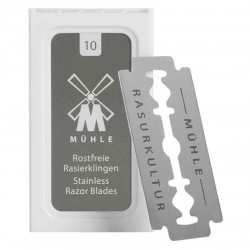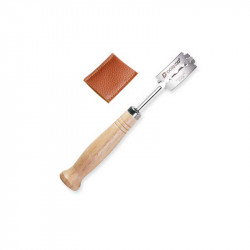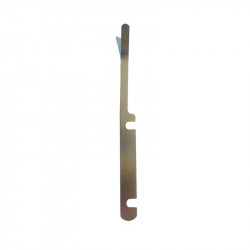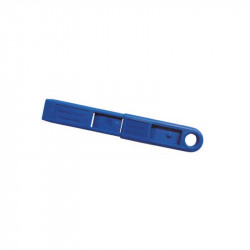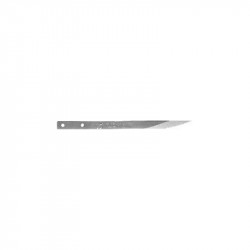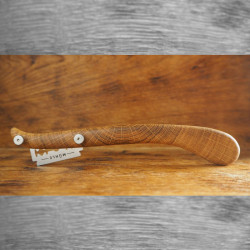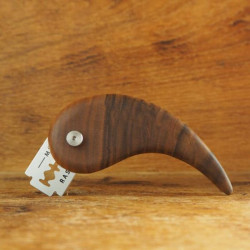Pastry knife
What is a pastry knife?
A dough knife, also known as a dough spatula or dough scraper, is a tool used in baking. It usually consists of a straight blade with a handle. The dough knife is used to cut, shape and knead dough. It is especially helpful with sticky dough because it prevents the dough from sticking to your hands. It can also be used to scrape dough from a work surface and for cutting into bread dough.
What is a baker's knife?
A baker's knife is a special knife used by bakers and pastry chefs. It is usually long and narrow, with a sharp blade. The baker's knife is mainly used for cutting bread and other baked goods. It can also be used to cut dough to portion or shape it. Some baker's knives have a serrated blade to make cutting hard crusts easier.
Which knife is best for cutting into dough?
A pastry knife or dough cutter is best for cutting into dough. This knife has a short, wide blade that is sharp and rigid enough to make even cuts in the dough without tearing it. A serrated edge can also be beneficial for creating beautiful patterns on the surface of the dough.
What is the difference between a normal knife and a baker's knife?
A regular knife is a general tool for cutting and slicing various foods. It has a sharp blade that is suitable for a variety of tasks.
A baker's knife, on the other hand, is designed specifically for use in the bakery. It has a long, narrow blade with a serrated or wavy edge. The serrations are used to cut through hard crusts or skins of pastries or bread more easily without squeezing or crushing the inside. It allows precise cutting of bread or pastries without crumbling or squashing.
Thus, a baker's knife is specifically designed and optimized for the requirements of baking, while a regular knife is a general tool for cutting various foods.
Do you need a baker's knife or pastry knife for cutting into dough?
Yes, a baker's knife or pastry knife is often used to cut into dough before baking. Cutting in creates small cracks in the surface of the dough, which ensure that the dough rises evenly during baking and does not form cracks or bubbles. Otherwise, a baker's knife can also be useful for other tasks in the bakery, such as cutting rolls or shaping pieces of dough.
What to look for when buying a baker's knife on it?
When buying a baker's knife, you should pay attention to the following points:
1. blade: The blade should be made of high-quality stainless steel and have a sharp edge. A good blade hardness enables precise cutting of bread and pastries.
2. Size: The size of the knife should be adapted to your own needs. A baker's knife with a blade between 20 and 25 cm is well suited for cutting bread and is sufficiently handy.
3. Handle: The handle should be ergonomically shaped and non-slip so that the knife lies securely in the hand and allows good control when cutting. A handle made of wood or plastic is recommended because it is easy to clean.
4. Weight: The weight of the baker's knife should be comfortable in the hand to allow good balance and control when cutting. A knife that is too heavy can tire quickly.
5. Care: A baker's knife should be easy to clean. A blade with a smooth surface and a dishwasher-safe feature are advantageous.
6. Value for money: A good baker's knife does not have to be expensive. It is worth comparing different models and reading customer reviews to find a high-quality knife at a reasonable price.
How to use a dough knife or baker's knife?
A dough knife or baker's knife is a tool used in baking to cut or shape dough. Here are some steps on how to use a dough knife:
1. Cut dough: Hold the pastry knife firmly and gently push the sharp, curved blade through the dough. You can use it to cut dough into pieces or to scrape dough off a surface.
2. Folding dough: If you need to fold dough while baking, you can use the dough knife to gently fold and shape the dough. Slide the blade under the dough and lift it up to fold it.
3. Smoothing dough: A dough knife can also be used to smooth and shape dough. Gently press the blade onto the dough and pull it into a desired shape or smooth surface.
4. Divide dough: If you need to divide the dough into smaller pieces, you can use the dough knife to cut it into even pieces. Gently push the blade through the dough to divide it into the desired portions.
Always watch your fingers when working with a pastry knife and keep it out of the reach of children. Also, make sure the knife is sharp to allow for proper cutting of the dough.
Which breads can be perfectly cut with a dough knife or baker's knife?
A dough knife or baker's knife can be used to cut into various types of bread perfectly. These include:
1. Baguette: The elongated format of the baguette can be cut in well with a dough knife or baker's knife. The typical diagonal incisions make for a beautiful appearance and allow for good expansion during baking.
2. Ciabatta: Similar to the baguette, the ciabatta can also be perfectly incised with a pastry or baker's knife. The incisions here should be rather straight and lengthwise.
3. Rye bread: Cutting a diamond or square pattern on the top of the rye bread allows it to rise better during baking. A sharp dough knife or baker's knife works especially well for this cut.
4. Whole grain bread: Whole grain breads can also be cut well with a dough knife or baker's knife. Here you can use different patterns, such as diagonal lines or spiral incisions.
5. Brioche: The sweet brioche bread can also be cut well with a dough or baker's knife. Here, in particular, you can cut a quarter-turn spiral on the top for an attractive look.
How to change the blade of a dough knife or baker's knife?
To replace the blade of a pastry knife or baker's knife, you should follow these steps:
1. Remove the old blade: Most models have a clamp or locking device on the back of the handle. Loosen this to expose the blade.
2. Remove the clamp or locking device: This may vary depending on the model. Some blades use a screw or bolt, others may have a clip or pin. Carefully remove the appropriate fastener to release the blade.
3. Remove the old blade: Carefully pull the old blade out of the knife handle. Be careful not to hurt your fingers.
4. Insert the new blade: Take the new blade and slide it into the handle of the knife until it is secure.
5. Attach the clamp or locking device: Replace the attachment device and fasten it tightly to hold the blade in place. Make sure it is secure and does not wobble.
If you are unsure or have difficulty replacing the blade, it is advisable to check the manufacturer's instructions or consult a professional.
What is the difference between smooth, serrated or curved dough knives?
The differences between smooth, serrated and curved dough knives and baker's knives lie in their functionality and range of use:
1. Smooth dough knife: This knife consists of a straight blade and is used to smooth, portion or cut dough. It is good for simple cutting tasks, such as separating pieces of dough or cutting cookies.
2. Serrated Dough Knife: Unlike plain knives, a serrated dough knife has a serrated blade. The teeth on the blade make it easier to cut hard or crunchy dough, such as pizza dough or puff pastry. The serrations can better penetrate the dough for easier and more even cutting.
3. Curved Pastry Knife: A curved pastry knife has a slightly curved blade instead of a straight blade. This shape makes it easier to cut and scrape dough from the work surface. It is especially good for cutting spaetzle, pasta or larger pieces of dough because the curved blade allows for a better angle.
Ultimately, choosing the right dough knife depends on the type of dough and the desired cutting technique.
Which dough knife and baker's knife is suitable for which bread?
In general, dough knives and baker's knives are suitable for the different types of bread:
1. Dough knife: The dough knife has a long, narrow blade and is mainly used for cutting dough. It is particularly suitable for bread doughs, pizza doughs or pastry doughs.
2. Baker's knife: The baker's knife, also known as a bread knife, has a long, wavy blade. It is especially good for cutting bread. The waves help cut through the hard crust of the bread without crushing the soft interior. The baker's knife is suitable for all types of bread, including baguettes, whole wheat bread or croissants.
It is important that the knives are sharp for clean and even cutting.
Is a pastry knife with a replaceable blade better?
A dough knife with a replaceable blade can have certain advantages. Here are some reasons why it could be considered better:
1. Hygiene: Replacing the blade can ensure better hygiene. After use, the blade can be easily replaced and cleaned, reducing the risk of cross-contamination of food.
2. Sharpness: over time, a blade can become dull and affect the performance of the pastry knife. Replacing the blade keeps the dough knife sharp and allows for precise and effortless cuts.
3. Versatility: Depending on preferences and requirements, a replaceable blade can provide different options. Different blade types could be available, such as serrated blades for fluted or notched cuts.
4. Durability: Typically, the blade is the part of the pastry knife that wears out the most. Replacing the blade can extend the life of the dough knife because you only need to replace the blade instead of having to replace the entire knife.
However, it is important to note that satisfaction with a dough knife with a replaceable blade depends on individual preferences and needs. Some people may prefer a traditional dough knife with a fixed blade. So, in the end, the choice depends on personal preferences.

